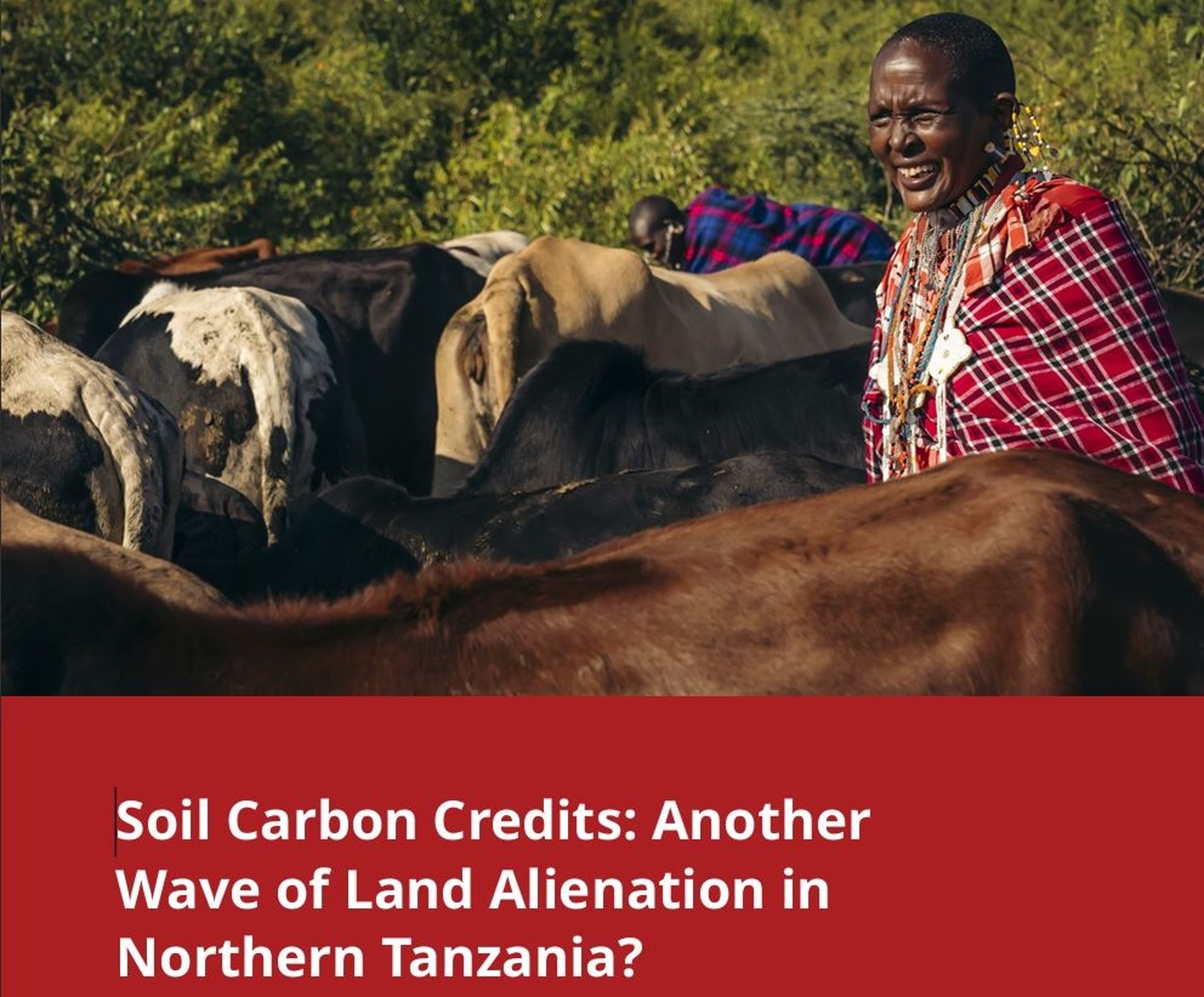
UNESCO
Successes
We have also raised concerns about the lack of transparency of the last Global Geopark mission, which was conducted without involving legitimate local communities. We have analysed and critiqued the last Tanzanian government’s report, which claimed that local communities were involved in the management of the Geopark. Which is wrong.
Read our letter to the Global Geopark Council, wherein we urge its voting members not to revalidate the Ngorongoro-Lengai Global Geopark and reject the 2024 revalidation report on the grounds that its findings are illegitimate without input from affected communities, including us. This is particularly problematic, because much of the infrastructure and tourist attractions are planned in predominantly Maasai areas. The letter is emblematic of UNESCO’s repeated exclusion of the Maasai in the management of both the World Heritage Site and the Geopark, contrary to UNESCO’s own rules of procedure.
Read FIAN Germany’s critique of UNESCO, which highlights UNESCO’s blind eye to the human and land rights violations taking place in the Ngorongoro Conservation Area. UNESCO’s recommendations in support of fortress conservation have made it complicit in the removal of basic social services infrastructure that served the food, medical, housing, and educational needs of the Maasai, along with forced evictions from the area.
Read the Tanzanian government’s latest report on the Ngorongoro Conservation Area (NCA) and response to UNESCO recommendations. The government argues against the UNESCO decision that a multiple land use model is relatively advantageous, falsely claims that its actions in the NCA are the result of community engagement, and rejects complaints from local communities and stakeholders. You can read MISA’s response to the report here.
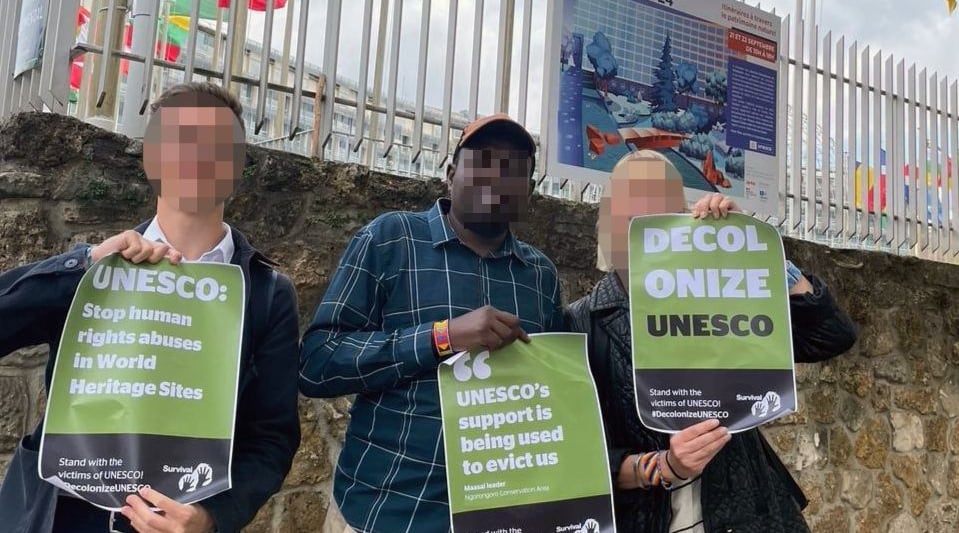

The status of a World Heritage Site has resulted in a number of decisions and recommendations that have been detrimental to our human and land rights. UNESCO has promoted a conservation approach that targets local and Indigenous Peoples’ ways of life, framing us and our activities as threats to “nature,” leading to narratives that emphasise overgrazing and carrying capacity over human rights. In March 2019, for example, a joint monitoring mission report from the UNESCO World Heritage Centre (WHC), the International Union for Conservation of Nature (IUCN) and the International Council on Monuments and Sites (ICOMOS) stated: “The NCAA (NCA Authority) urgently needs to implement stringent policies to control population growth and its subsequent impact on the OUV (outstanding universal value)."
A MISA delegation, in front of the Paris headquarters, calls on UNESCO to implement inclusive policies that respect Indigenous Peoples’ rights. Credit: MISA.
This approach has legitimised and emboldened the Tanzanian government’s human rights abuses against us. The negative impacts of UNESCO and World Heritage Committee recommendations on our communities include significant threats to food security, the removal of social services and forced eviction. Resulting human rights violations also include a lack of our involvement, participation, and consultation in the management of the World Heritage Site.
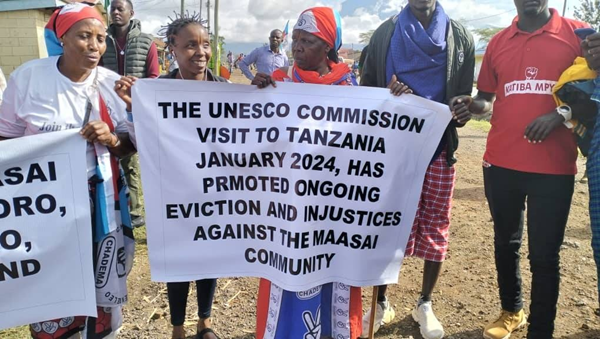

A peaceful demonstration was held against the lack of transparency and consultation of Indigenous Peoples by the UNESCO Advisory Mission to Ngorongoro World Heritage Site. Credit: MISA.
We have been engaging with UNESCO to demand transparency and accountability in the context of recent investigative missions. We have also emphasised the negative impacts of the exponential increase in tourism development and tourism infrastructure, which is anticipated to continue to grow, with over 1,2 million visitors to NCA in 2025.
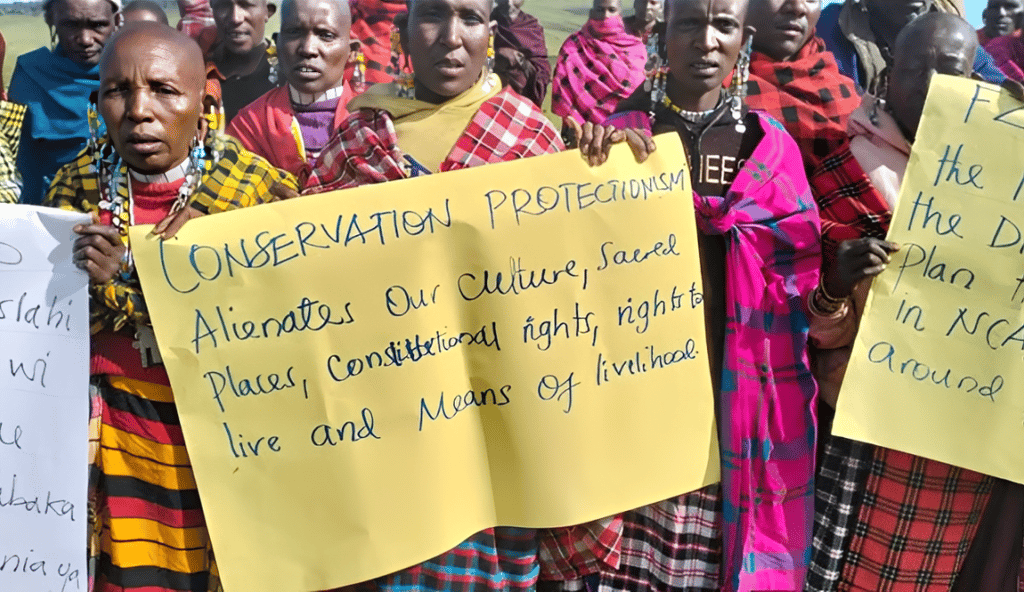

Maasai activists denounced organized protests against the theft of their lands in the name of conservation on World Heritage Day (April 18). Credit: MISA.
ADDITIONAL RESOURCES
In February 2024, a joint WHC/IUCN/ICOMOS advisory mission to the NCA was conducted. We consider the February mission null and void, as it only spoke to government-appointed stakeholders and did not meet with legitimate representatives of the Maasai in the NCA. On 18 April 2024, World Heritage Day, residents of Ngorongoro organized coordinated protests against UNESCO.
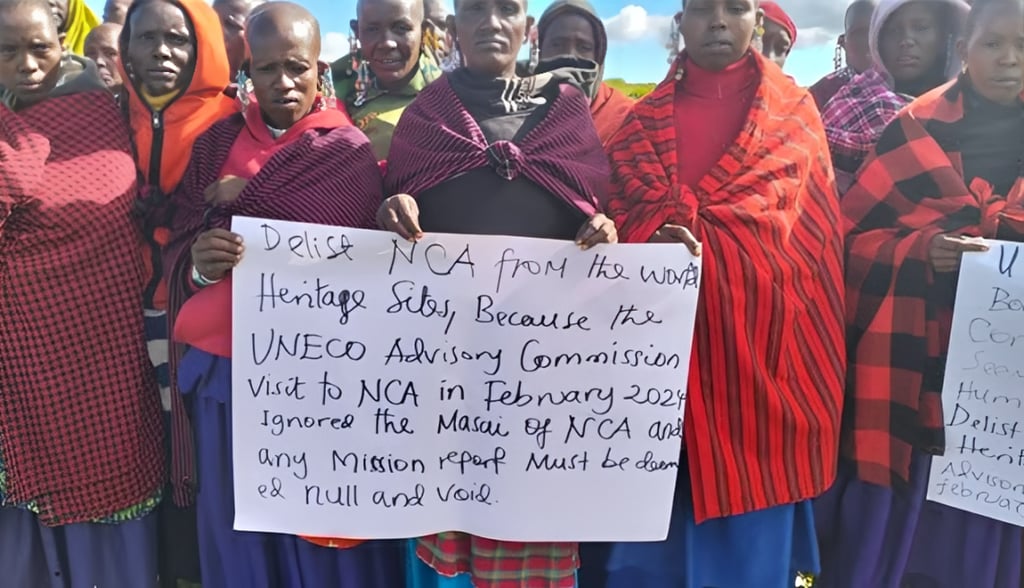

Maasai activists denounced organized protests against the theft of their lands in the name of conservation on World Heritage Day (April 18). Credit: MISA.
We consider it a success of our collective advocacy efforts that, following our complaints, UNESCO decided not to publish the report of this mission. Our Maasai communities organised protests on World Heritage Day (April 18 2024) against the theft of our lands in the name of conservation, asking UNESCO to stop supporting fortress conservation and to delist the NCA from the World Heritage list. At the World Heritage Council (WHC) meeting of July 2024 in Delhi, which MISA representatives attended, State parties decided that a reactive monitoring mission should be conducted. At the WHC meeting in Paris in July 2025, the Decision that was adopted on Ngorongoro is useful in three ways: a) it supports the Multiple Land Use Model (MLUM) and calls for a human-rights based approach to its implementation; b) it insists that rights-holders be involved in the development of the General Management Plan for Ngonrogonro and in the MLUM implementation strategy, including “those opposed to relocation;” and c) it requests that an invitation be extended for a reactive monitoring mission to visit NCA “at the earliest opportunity.”
Our submission to the World Heritage Committee (WHC) 2025 in Paris
Read our letter to the WHC, which we submitted ahead of the 47th annual meeting in Paris. The purpose of the letter is to rectify false and inaccurate information provided by the Tanzanian government in its state party report (see “Tanzanian government’s report on Ngorongoro” below). Our letter contests the government’s negative claims on the Multiple Land Use Model (MLUM) as well as the so-called “voluntary relocation” of Maasai out of Ngorongoro. We also support UNESCO’s call for more inclusive engagement of affected actors in future UNESCO advisory missions and the reiterated call for a full assessment on the environmental impacts of tourism infrastructure expansions. Despite UNESCO’s moratorium on new developments until after the assessment has been completed, the government has moved forward with constructing new hotels. Lastly, we highlight that residents of the Ngorongoro Conservation Area (NCA) are not consulted in the development of the government’s General Management Plan which entails various management and conservation efforts in the NCA.
World Heritage Committee (WHC) State of Conservation report (2025)
Read pages 22-26 for the state of conservation of the Ngorongoro Conservation Area. We welcome the fact that the report calls for the continued multiple land use approach with a clear human rights-based approach. However, the report does not include any mention of Indigenous Peoples nor the reactive monitoring mission. Additionally, we are concerned that the use of MLUM “with some adjustments” could serve as a vehicle for implementing land use restrictions in key areas, ultimately threatening pastoralism.
Tanzanian government’s report on Ngorongoro
MISA-UNESCO Position Paper
Read more about MISA’s engagement with UNESCO on the Ngorongoro World Heritage Site and the Ngorongoro-Lengai Global Geopark in our position paper, which highlights how UNESCO and World Heritage Committee recommendations have legitimized and encouraged the Tanzanian government’s attacks on the Maasai. It details the negative impacts and human rights violations occurring in the Ngorongoro Conservation Area.
MISA letter to Geopark Council
„UNESCO-Welterbetag“: Heftige Kritik an der UNESCO
The United Nations Educational, Scientific and Cultural Organization (UNESCO) has given the Ngorongoro Division several designations, including that of a Natural World Heritage Site, part of the Serengeti-Ngorongoro Biosphere Reserve and as a part of the Ngorongoro-Lengai Global Geopark. We have never given our free, prior and informed consent (FPIC) to these designations. The other Indigenous groups living in the area, such as the Barabaig or the Hadza, have also not given their consent.
.
.
We have been engaging with UNESCO to demand transparency and accountability in the context of recent investigative missions. We have emphasised the negative impacts of the exponential increase in tourism development and tourism infrastructure, which is anticipated to continue to grow, with over 1,2 million visitors to NCA in 2025.

